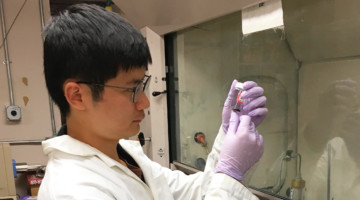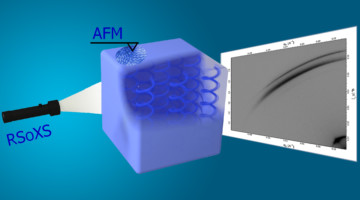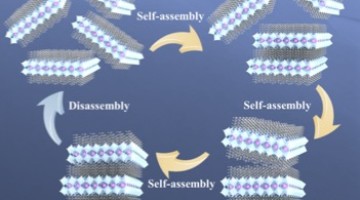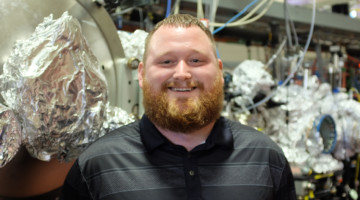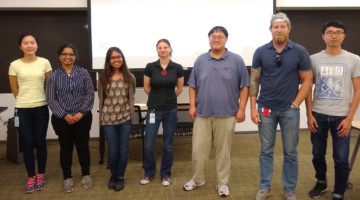Using the computer game, “Foldit,” nonexpert citizen scientists designed new proteins whose structures, verified at the ALS, were equivalent in quality to and more structurally diverse than computer-generated designs. The work shows the potential of using crowd-based creativity in the design of new proteins for fighting illness and disease. Read more »![]()
![]()
ALSNews Vol. 409
September 25, 2019
Controlling Spin in Antiferromagnetic Nanostructures
Researchers discovered that the spin configuration of a nanostructured antiferromagnetic material can be affected by the dimensions of features imprinted onto the material. The results suggest that nanoscale patterning can be a viable tool for engineering spin configurations in future antiferromagnetic spintronic devices. Read more »![]()
![]()
Padraic Shafer to Receive the 2019 Shirley Award
Congratulations to Padraic Shafer, this year’s recipient of the Shirley Award for Outstanding Scientific Achievement! Shafer, ALS staff scientist and leader of the ALS’s dichroism program, is being recognized “for unveiling the nature of chiral quantum materials through the innovative use of x-ray scattering at the Advanced Light Source.” Read more »
ALS Confirms Mechanism for Improved Fuel Cell Catalysis
Aided by x-ray absorption spectroscopy at the ALS, researchers from Toyota and the University of Akron have uncovered a new catalysis mechanism to improve oxidation-reduction reactions in certain fuel cells by 40%. This enhancement, based on tin oxide, will support efforts to increase fuel efficiency in electric vehicles. Read more »![]()
Multiple Levels of Chirality from Achiral Molecules
Liquid crystal samples were found to exhibit up to four levels of chirality, despite being made up of achiral molecules. The work sheds light on how molecular properties and competing interactions “propagate” order from the molecular level up to the microscale, leading to complexity similar to that found in biological materials. Read more »
Self-Assembling Nanomaterials Are Organized and Tunable
Perovskite superlattices have a wide variety of applications, but they are difficult to synthesize. Researchers have now characterized their self-assembly process to better understand how to create a variety of superlattice materials. Read more »
Terry McAfee, Resonant Soft X-Ray Scattering Postdoc
Terry McAfee started coming to the ALS during his PhD. The Northern California native is glad to be back as a postdoc and hopes to stay on as a beamline scientist. He enjoys developing new techniques and working with users, always looking for ways to contribute to the community. Read more »
Last Chance to Register for the 2019 ALS User Meeting (October 1–3)
The last day to register online for the 2019 ALS User Meeting is September 26. The event will feature news from DOE, keynote talks, updates on the ALS-U Project, 11 focused workshops and tutorials, a student poster “slam,” an exhibitor tent, and the presentation of awards at the annual banquet. To register and view the draft agenda and logistical information, visit the User Meeting webpage.
Doctoral Fellows in Residence Wrap Up Year at the ALS
After spending a year at the ALS, our doctoral fellows in residence are preparing to return to their home institutions. Before leaving, they gave lightning talks on the work they did at the beamlines and what else they did in the Bay Area. Read more »
In Memoriam: Dave Humphries, Staff Engineer
We are saddened by the death of our friend and colleague, Dave Humphries. During his long tenure at Berkeley Lab and at the ALS in particular, Dave contributed in many outstanding ways to the success of the Laboratory and of our facility. Dave was at home with his family and passed away peacefully on September 13, 2019. Read more »



